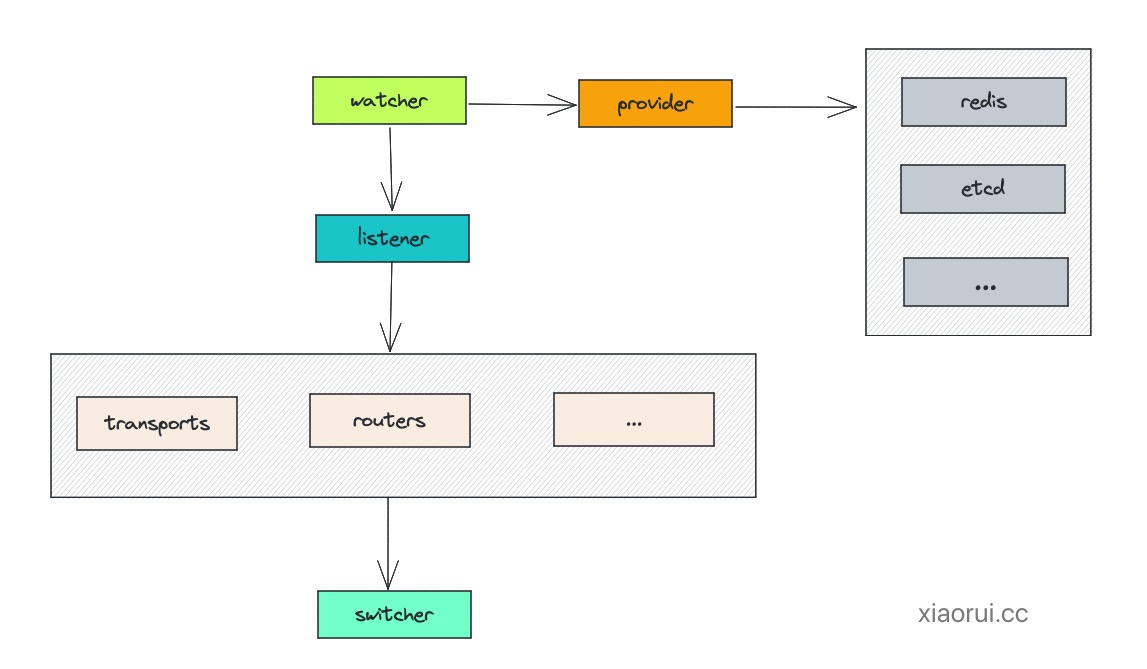像 nginx 是支持配置更新,只是不支持动态的配置发现更新,需要外加插件才可以,不加插件只能手动改文件,然后通过 nginx -s reload 来更新,reload 的实现错误是 master 收到信号后重载配置,fork 新的 worker 子进程,最后优雅干掉老配置的 worker 子进程.
基于 openresty 的 kong 和 apisix 都是支持动态配置更新的.
traefik 是支持配置的动态更新,那么 traefik 作为高性能网关,如何在不影响业务的情况下,实现配置的动态更新 ?
通过分析代码后,得知动态更新主要依赖 watcher,listener, provider, switcher 设计来实现的,缺一不可呀. 😁
- watcher 动态配置的主逻辑,关联了 listener, provider.
- listener 实现具体配置在 traefik 里的更新.
- provider 实现发现配置及监听是否变更.
- switcher 抽象了 http.Handler, tcp.Handler 等逻辑,每次读取或变更时,都需要加锁以保证线程安全.
首先 traefik 在 cmd 初始化阶段, 通过 setupServer 进行实例化 provider 和 watcher 对象.
func setupServer() {
...
// 根据 provider 类型做实例化 provider.
providerAggregator := aggregator.NewProviderAggregator(*staticConfiguration.Providers)
// 创建 watcher 监听和更新配置.
watcher := server.NewConfigurationWatcher(
routinesPool,
providerAggregator,
getDefaultsEntrypoints(staticConfiguration),
"internal",
)
...
}watcher 实现了配置监听和更新的主逻辑,内会启动了三个协程.
- receiveConfigurations, 监听配置更新, 对比本地配置并发送通知
- applyConfigurations, 应用配置更新, 调用上层传递 listener 回调方法,使各个组件都被动更新
- startProviderAggregator, 调用 provider 的 provide 接口,传递一个 chan 和 协程池wg
// NewConfigurationWatcher creates a new ConfigurationWatcher.
func NewConfigurationWatcher(
routinesPool *safe.Pool,
pvd provider.Provider,
defaultEntryPoints []string,
requiredProvider string,
) *ConfigurationWatcher {
return &ConfigurationWatcher{
}
}
// Start the configuration watcher.
func (c *ConfigurationWatcher) Start() {
c.routinesPool.GoCtx(c.receiveConfigurations)
c.routinesPool.GoCtx(c.applyConfigurations)
c.startProviderAggregator()
}
// Stop the configuration watcher.
func (c *ConfigurationWatcher) Stop() {
close(c.allProvidersConfigs)
close(c.newConfigs)
}
// AddListener adds a new listener function used when new configuration is provided.
func (c *ConfigurationWatcher) AddListener(listener func(dynamic.Configuration)) {
if c.configurationListeners == nil {
c.configurationListeners = make([]func(dynamic.Configuration), 0)
}
c.configurationListeners = append(c.configurationListeners, listener)
}switcher 这个名字起的有点怪,traefik 各个组件都有 switcher 的实现,比如 http 里的 switcher 实现了 http.handler 接口,tcp 的 switcher 实现了 tcp.handler 接口. switcher 本质就是 sync.Map + interface{} 组合,目的为了线程安全获取和动态更新 handler.
这样当每次请求需要处理时,都会从 switcher.safe 里加锁获取 http.Handler, 当 watcher 配置动态更新的时候,也是加锁的更新 http.Handler.
下面是 http switcher 的结构设计:
type HTTPHandlerSwitcher struct {
handler *safe.Safe
}
func NewHandlerSwitcher(newHandler http.Handler) (hs *HTTPHandlerSwitcher) {
return &HTTPHandlerSwitcher{
handler: safe.New(newHandler),
}
}
func (h *HTTPHandlerSwitcher) ServeHTTP(rw http.ResponseWriter, req *http.Request) {
handlerBackup := h.handler.Get().(http.Handler)
handlerBackup.ServeHTTP(rw, req)
}
func (h *HTTPHandlerSwitcher) GetHandler() (newHandler http.Handler) {
handler := h.handler.Get().(http.Handler)
return handler
}
func (h *HTTPHandlerSwitcher) UpdateHandler(newHandler http.Handler) {
h.handler.Set(newHandler)
}配置的动态更新是通过 listener 来实现的. traefik 里有不少动态更新,这里重点说下两个配置更新.
- server trasnports 连接池
- routers 路由匹配策略
server transports 的监听器在当配置更新时,会对 RoundTripper 管理器加锁, 然后新建 transport 连接池, 老的池子不去管,因为 http 组件也是每次通过 Get() 实时获取的 roundTripper,在当前的请求都处理完毕后,http 就不会再复用引用这个要销毁的 RoundTripper, 后面依赖空闲超时 idleConnTimeout 去关闭连接.
// Server Transports
watcher.AddListener(func(conf dynamic.Configuration) {
roundTripperManager.Update(conf.HTTP.ServersTransports)
})roundTripper update 的逻辑实现,先去除老的配置,并分析配置否是有变更,对于产生变更的新建连接池,对于新增的 transport 配置则直接新创建.
func (r *RoundTripperManager) Update(newConfigs map[string]*dynamic.ServersTransport) {
r.rtLock.Lock()
defer r.rtLock.Unlock()
for configName, config := range r.configs {
// 去除老的配置
newConfig, ok := newConfigs[configName]
if !ok {
delete(r.configs, configName)
delete(r.roundTrippers, configName)
continue
}
// 如果新旧配置相等, 则无需更新
if reflect.DeepEqual(newConfig, config) {
continue
}
var err error
// 对于有变更的配置,实例化新 roundTripper 连接池.
r.roundTrippers[configName], err = r.createRoundTripper(newConfig)
}
for newConfigName, newConfig := range newConfigs {
if _, ok := r.configs[newConfigName]; ok {
continue
}
var err error
// 对于没有的,实例化连接池
r.roundTrippers[newConfigName], err = r.createRoundTripper(newConfig)
}
r.configs = newConfigs
}关于 router 的监听器,当配置更新时,重新创建 tcpRouters 和 udpRouters 路由,然后分别在 tcp 和 udp 的 entrypoint 上做更新, 遍历更新到各个组件的 switcher 上,本质就是个加了锁的 value.
// Switch router
watcher.AddListener(switchRouter(routerFactory, serverEntryPointsTCP, serverEntryPointsUDP))在 tcp 和 udp 上更新 routers.
func switchRouter(routerFactory *server.RouterFactory, serverEntryPointsTCP server.TCPEntryPoints, serverEntryPointsUDP server.UDPEntryPoints) func(conf dynamic.Configuration) {
return func(conf dynamic.Configuration) {
rtConf := runtime.NewConfig(conf)
routers, udpRouters := routerFactory.CreateRouters(rtConf)
serverEntryPointsTCP.Switch(routers)
serverEntryPointsUDP.Switch(udpRouters)
}
}
// Switch the TCP routers.
func (eps TCPEntryPoints) Switch(routersTCP map[string]*tcprouter.Router) {
for entryPointName, rt := range routersTCP {
eps[entryPointName].SwitchRouter(rt)
}
}
// SwitchRouter switches the TCP router handler.
func (e *TCPEntryPoint) SwitchRouter(rt *tcprouter.Router) {
...
httpHandler := rt.GetHTTPHandler()
...
e.httpServer.Switcher.UpdateHandler(httpHandler)
rt.SetHTTPSForwarder(e.httpsServer.Forwarder)
...
httpsHandler := rt.GetHTTPSHandler()
e.httpsServer.Switcher.UpdateHandler(httpsHandler)
e.switcher.Switch(rt)
e.http3Server.Switch(rt)
}provider 是用来实现监听配置的动态更新以及获取变更通知的。逻辑相对简单,就是监听配置是否有变更,当发生变更后,通知给 watcher, watcher 在把事件传递给一个个的 listener 做具体的配置变更.
比如可以把配置的放到 etcd 上,当在 etcd 上做了更新后,通知给 traefik 做变更. traefik 实现了不少 provider,有本地文件、docker、etcd、redis、consul、http、 k8s crd 等.
基于文件的 provider 的实现,源码还是简单的. 首先需要实现 Provide 接口,该方法通过 inotify 来监听文件的更新事件,当发生变动时,会通知给上层传递的 configurationChan chan<- dynamic.Message 通道.
func (p *Provider) Provide(configurationChan chan<- dynamic.Message, pool *safe.Pool) error {
configuration, err := p.BuildConfiguration()
if err != nil {
return err
}
if p.Watch {
var watchItem string
...
if err := p.addWatcher(pool, watchItem, configurationChan, p.watcherCallback); err != nil {
return err
}
}
sendConfigToChannel(configurationChan, configuration)
return nil
}
func (p *Provider) watcherCallback(configurationChan chan<- dynamic.Message, event fsnotify.Event) {
sendConfigToChannel(configurationChan, configuration)
}
func sendConfigToChannel(configurationChan chan<- dynamic.Message, configuration *dynamic.Configuration) {
configurationChan <- dynamic.Message{
ProviderName: "file",
Configuration: configuration,
}
}traefik 使用 github.com/kvtools/valkeyrie 实现常见 kv 存储的读写接口, 所以在 traefik 看不到各类 kv 数据库读写实现. kv provider 的实现跟 file provider 大同小异.
// Provide allows the docker provider to provide configurations to traefik using the given configuration channel.
func (p *Provider) Provide(configurationChan chan<- dynamic.Message, pool *safe.Pool) error {
configuration, err := p.buildConfiguration(ctx)
if err != nil {
} else {
configurationChan <- dynamic.Message{
ProviderName: p.name,
Configuration: configuration,
}
}
pool.GoCtx(func(ctxPool context.Context) {
err := p.watchKv(ctxLog, configurationChan)
})
return nil
}
func (p *Provider) watchKv(ctx context.Context, configurationChan chan<- dynamic.Message) error {
operation := func() error {
events, err := p.kvClient.WatchTree(ctx, p.RootKey, nil)
for {
select {
...
case _, ok := <-events:
configuration, errC := p.buildConfiguration(ctx)
if configuration != nil {
configurationChan <- dynamic.Message{
ProviderName: p.name,
Configuration: configuration,
}
}
}
}
}
...
return nil
}traefik 的动态配置更新是由 watcher,listener, provider, switcher 组合实现的.
- watcher 动态配置的主逻辑,关联了 listener, provider.
- listener 实现具体配置在 traefik 里的更新.
- provider 实现发现配置及监听是否变更.
- switcher 抽象了 http.Handler, tcp.Handler 等逻辑,每次读取或变更时,都需要加锁以保证线程安全.
traefik 源码抽象的好,组合起来也顺,但分析源码时还是有些绕的,每个单元看起来都好懂,反而衔接起来反而不易懂。
